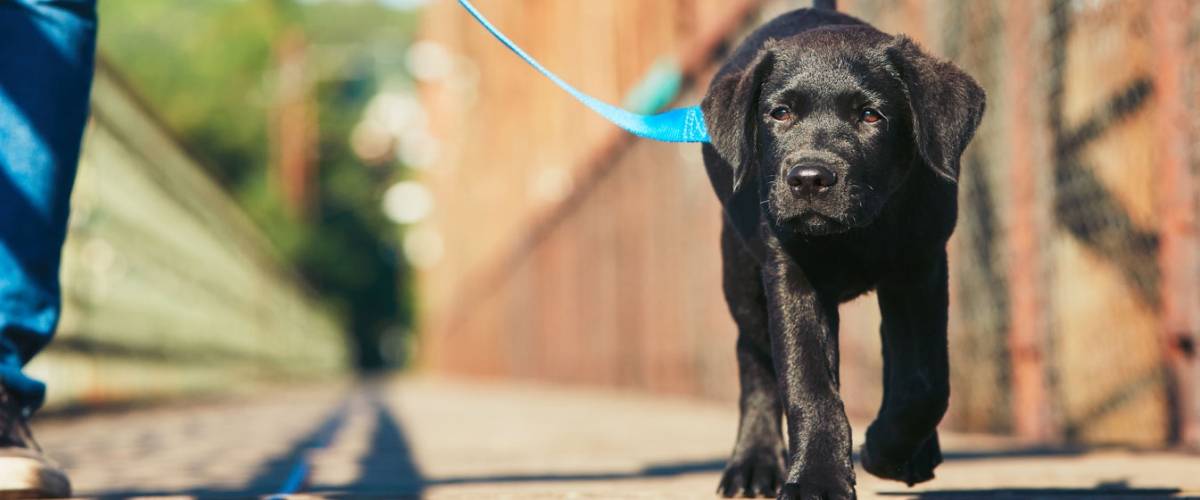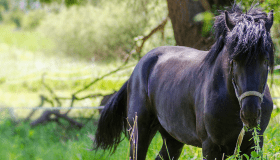
Updated December 18, 2018 – At its best, walking your dog is a pleasant and enjoyable experience for the sentient beings at both ends of the leash. You and your furry friend take in the sights and sounds of the outdoors and you feel no tension on the leash because his paws trot right next to your feet.
But how many of us experience something… a little different? Dogs that jump around, bite at the leash, lunge at other dogs, chase squirrels and bunnies, and drag us all over creation with what sometimes feels like the strength and determination of an alligator until the walk (mercifully) comes to an end. Is it the breed? Your dog’s age? Can anything be done?
“All dogs can be trained. You just need to find the right routine,” says Dr. Sharon Albright, a canine behavior specialist and avid trainer of her own dogs, Reese and Blaze, as well as others.
Dr. Albright has been a veterinarian for 18 years, but a student of animal behavior even longer. She got her first dog as an undergraduate student and immediately enrolled her new pup in obedience class. Still an avid trainer, she said it’s her passion to help owners relate better with their pets.
“It’s really cool to communicate with a different species,” Dr. Albright says. “And when you do it well, it takes your relationship and your interaction with that species to another level.”
We asked Dr. Albright a few questions to help you relate better with your dog on walks, and make the interaction a more pleasant one for everybody.
Is there a proper way a dog should walk with you on a leash?
“Personal preference determines exactly what an enjoyable leash walk means to you,” Dr. Albright says. “While AKC obedience competition rules dictate a formally defined heel position, with the dog’s shoulder in line with the seam of your left pant leg, that’s not necessary for most of us to have a good, safe walk with our dogs.”
My dog is so distracted by all the sights and smells. How can I get him to focus on me?
For successful walks, Dr. Albright says a big trick is to make being near you, the human, at least, if not more fun, than being out exploring. Move at a decent tempo, put the cell phone away and pay attention to your dog.
“If you want the dog to be engaged with you, you have to be engaged with your dog,” she says. “As a human, we just think we’re just going for a casual walk, but you actually have work to do if you want your dog to not pull. You have to make being near you worthwhile.”
Should I bring treats?
High value treats or toys are great.
“Make sure the treats you bring are more enticing than whatever your dog wants to smell on the side of the trail,” Dr. Albright says. “It may take trial and error, but consider creating a ranked list of rewards for your dog for good behavior.”
What if my dog still starts to pull?
“You can either stop, back up or change direction. They will have to pay closer attention to you since they don’t know which way you’ll want to move next,” Dr. Albright says. “They never get to move forward unless the leash is loose.”
When should I start training my dog to walk on a leash?
As early as possible. For puppies, Dr. Albright says let them get used to a leash by just clipping it on and letting them drag it around the house, so long as they don’t get tangled or chew on it.
“Every now and then, just pick up the end and walk around with them, giving them reassurance. Gradually take the puppy out to the back yard, then front yard, for longer periods of time, with rewards and encouragement along the way. Eventually you will graduate to full walks as long as you both like.”
Can older dogs learn to walk better?
“Dogs, like people, learn every day,” Dr. Albright says. “It may require more patience and understanding. You have to realize that they have a history of behavior that needs to be retrained – that you’re changing the rules. But, yes, even old dogs can learn new tricks.”
Is it OK if I relax the rules every now and then?
Actually, consistency is the most important piece of the puzzle.
“If we got a speeding ticket every time the speedometer went one mile over the speed limit, we sure wouldn’t speed, would we?” Dr. Albright says. “But because it’s so intermittent – and we can go years without tickets before we get caught – it isn’t a very effective consequence. So, if you’ve made progress with your dog and then let them pull, you might have just undone the last three weeks of training.”
Finally, Dr. Albright recommends finding a good obedience instructor to offer another perspective while working with your dog, as many of us get into bad habits and may not always realize what we are and aren’t teaching our pets.




